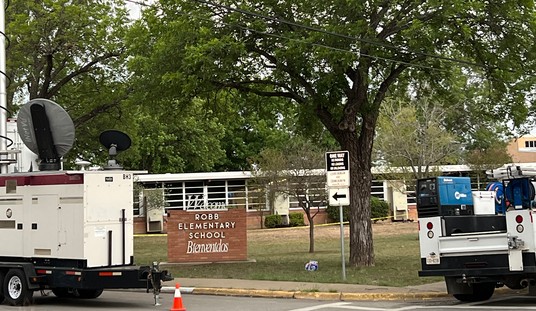Tensions continue to escalate in Europe, where another demonstration of Russian force prompted another demonstration of Western resolve — perhaps not quite in equal measure. After the Russians conducted tests of their Iskander-M land-based, nuclear-capable missile system in Kaliningrad, the US and UK pledged to build up forces on the eastern perimeter in Poland and Romania. The expansion, the largest since the end of the Cold War, will eventually produce a 4,000-troop presence along the Russian frontier.
That’s still a drop in the bucket compared to what it faces on the other side:
Britain said on Wednesday it will send fighter jets to Romania next year and the United States promised troops, tanks and artillery to Poland in NATO’s biggest military build-up on Russia’s borders since the Cold War.
Germany, Canada and other NATO allies also pledged forces at a defense ministers meeting in Brussels on the same day two Russian warships armed with cruise missiles entered the Baltic Sea between Sweden and Denmark, underscoring East-West tensions. …
NATO Secretary-General Jens Stoltenberg said the troop contributions to a new 4,000-strong force in the Baltics and eastern Europe were a measured response to what the alliance believes are some 330,000 Russian troops stationed on Russia’s western flank near Moscow.
“This month alone, Russia has deployed nuclear-capable Iskander missiles to Kaliningrad and suspended a weapons-grade plutonium agreement with the United States,” Stoltenberg said, also accusing Russia of continued support for rebels in Ukraine.
The plan does envision a secondary level of forces that will go to 40,000 troops, but the disparity has been part of the issue. Russia has maintained high troop levels on its side of the NATO line, worrisome in itself, but the recent tests in Kaliningrad have heightened the need for more readiness. No one knows whether the Russians have shipped nuclear-armed missiles to Kaliningrad with the Iskander-M launchers, but that wouldn’t be a tough trick to pull off, either.
Plus, the Russians have a new nuclear toy that they seem eager to show off as well. Meet the RS-28 Sarmat — a modern version of an ICBM with a much more reliable electronics infrastructure that NATO calls the “Satan 2” rocket:
The RS-28 Sarmat could carry a payload capable of wiping out a landmass “the size of Texas or France,” according to a report by the Kremlin-aligned Sputnik news agency.
Known colloquially as “Satan 2,” the missile will replace the RS-36M — which was dubbed “Satan” by NATO after entering service in the 1970s.
Robert Kelley, a former nuclear weapons expert at the U.S. Department of Energy, said the new missile was likely an upgrade of electronics — rather than explosive power or range.
The declassification by the Russians of this new weapon — which is expected to get deployed in late 2017 — sends a message too, and one that won’t easily be matched by the US. The Obama administration has been reluctant to spend money on modernizing our own nuclear capabilities, in part because Barack Obama has held out hope that he could bargain nuclear weapons out of existence. Six years ago, the Obama administration pledged to invest heavily in our nuclear infrastructure, but little progress has been made since even on the pledge for a replacement ICBM system slated for deployment in 2030. At a recent Council on Foreign Relations symposium, Undersecretary for Nuclear Security at the U.S. Department of Energy Frank G. Klotz underscored the issue:
I spent a lot of time as a missile launch officer. The Minuteman III, which is the current ICBM that we have, was deployed in the 1970s, and even then was put into siloes that were constructed in the early 1960s. And even the Ohio-class submarine, which is the most survivable leg of our triad, its life has already been extended from 30 years to 42 years, and the first of those submarines are going to begin to age out here in the next decade.
Same thing goes with the weapons. We have the smallest stockpile that we have ever had since the early Eisenhower administration, reaching a peak of around 31,000 in 1967, now down to the latest unclassified number 4,700 weapons. And that stockpile is also the oldest stockpile we’ve ever had. The average age of the weapons in our nuclear arsenal that go with those delivery systems is 27 years.
As Bill and I were talking about earlier, there was a time where we used to turn weapons over about once every 10 years or so. So in any event, if we’re going to maintain a safe, secure, and effective force, we’re going to need to do something to replace the existing delivery systems and extend the life of the nuclear weapons that we have.
The debate at the CFR involved whether the US had entered a new arms race with Russia and China. Perhaps a better way of framing it is whether we have entered a modernization race. If so, we started off with a large advantage, so it’s important not to give way to hysteria — but equally important to know we can be eclipsed if we continue to stand pat.
More importantly, Russia clearly takes all of this seriously. So far, we haven’t … until perhaps now. Perhaps.








Join the conversation as a VIP Member